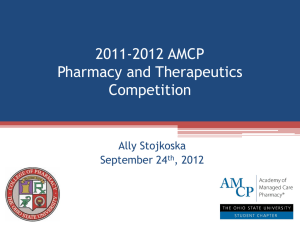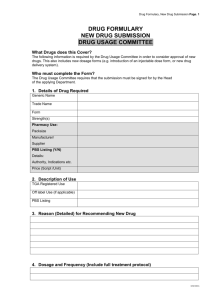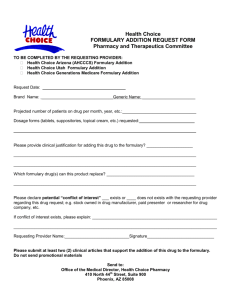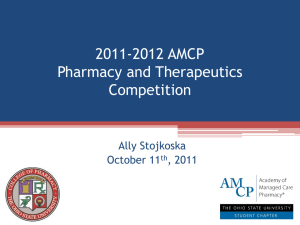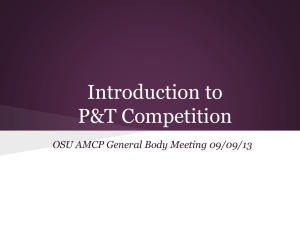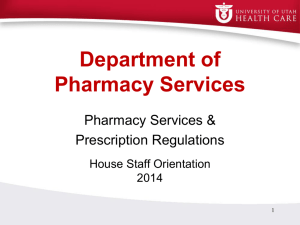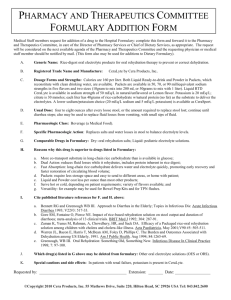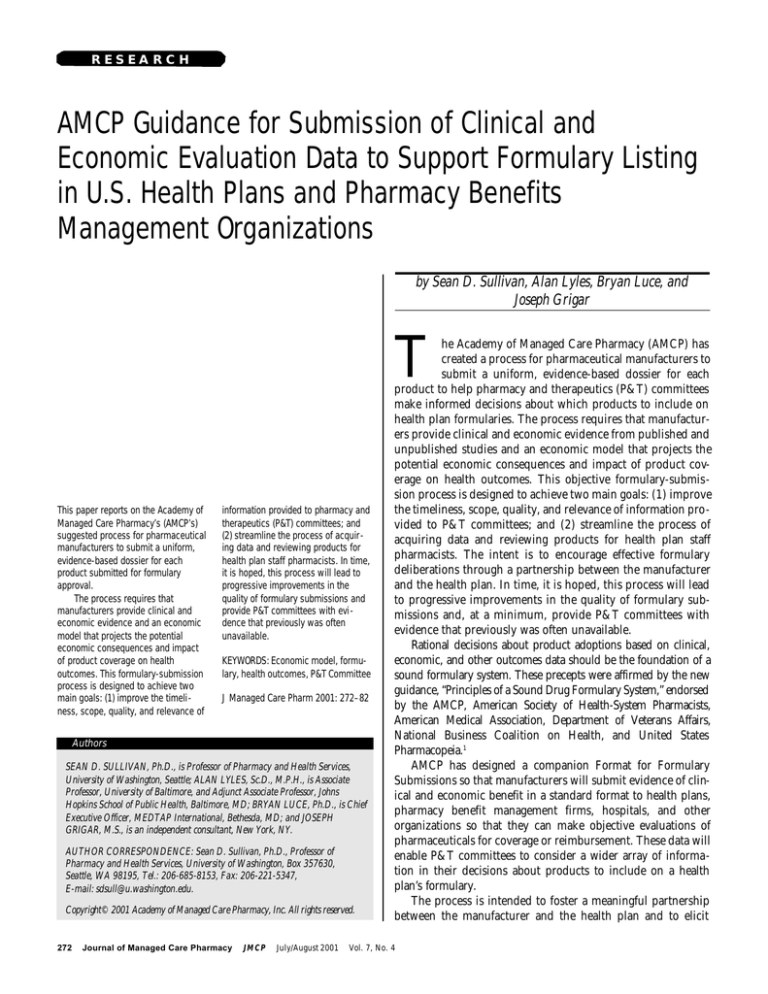
RESEARCH
AMCP Guidance for Submission of Clinical and
Economic Evaluation Data to Support Formulary Listing
in U.S. Health Plans and Pharmacy Benefits
Management Organizations
by Sean D. Sullivan, Alan Lyles, Bryan Luce, and
Joseph Grigar
T
This paper reports on the Academy of
Managed Care Pharmacy’s (AMCP’s)
suggested process for pharmaceutical
manufacturers to submit a uniform,
evidence-based dossier for each
product submitted for formulary
approval.
The process requires that
manufacturers provide clinical and
economic evidence and an economic
model that projects the potential
economic consequences and impact
of product coverage on health
outcomes. This formulary-submission
process is designed to achieve two
main goals: (1) improve the timeliness, scope, quality, and relevance of
information provided to pharmacy and
therapeutics (P&T) committees; and
(2) streamline the process of acquiring data and reviewing products for
health plan staff pharmacists. In time,
it is hoped, this process will lead to
progressive improvements in the
quality of formulary submissions and
provide P&T committees with evidence that previously was often
unavailable.
KEYWORDS: Economic model, formulary, health outcomes, P&T Committee
J Managed Care Pharm 2001: 272–82
Authors
SEAN D. SULLIVAN, Ph.D., is Professor of Pharmacy and Health Services,
University of Washington, Seattle; ALAN LYLES, Sc.D., M.P.H., is Associate
Professor, University of Baltimore, and Adjunct Associate Professor, Johns
Hopkins School of Public Health, Baltimore, MD; BRYAN LUCE, Ph.D., is Chief
Executive Officer, MEDTAP International, Bethesda, MD; and JOSEPH
GRIGAR, M.S., is an independent consultant, New York, NY.
AUTHOR CORRESPONDENCE: Sean D. Sullivan, Ph.D., Professor of
Pharmacy and Health Services, University of Washington, Box 357630,
Seattle, WA 98195, Tel.: 206-685-8153, Fax: 206-221-5347,
E-mail: sdsull@u.washington.edu.
Copyright© 2001 Academy of Managed Care Pharmacy, Inc. All rights reserved.
272
Journal of Managed Care Pharmacy
JMCP
July/August 2001
he Academy of Managed Care Pharmacy (AMCP) has
created a process for pharmaceutical manufacturers to
submit a uniform, evidence-based dossier for each
product to help pharmacy and therapeutics (P&T) committees
make informed decisions about which products to include on
health plan formularies. The process requires that manufacturers provide clinical and economic evidence from published and
unpublished studies and an economic model that projects the
potential economic consequences and impact of product coverage on health outcomes. This objective formulary-submission process is designed to achieve two main goals: (1) improve
the timeliness, scope, quality, and relevance of information provided to P&T committees; and (2) streamline the process of
acquiring data and reviewing products for health plan staff
pharmacists. The intent is to encourage effective formulary
deliberations through a partnership between the manufacturer
and the health plan. In time, it is hoped, this process will lead
to progressive improvements in the quality of formulary submissions and, at a minimum, provide P&T committees with
evidence that previously was often unavailable.
Rational decisions about product adoptions based on clinical,
economic, and other outcomes data should be the foundation of a
sound formulary system. These precepts were affirmed by the new
guidance, “Principles of a Sound Drug Formulary System,” endorsed
by the AMCP, American Society of Health-System Pharmacists,
American Medical Association, Department of Veterans Affairs,
National Business Coalition on Health, and United States
Pharmacopeia.1
AMCP has designed a companion Format for Formulary
Submissions so that manufacturers will submit evidence of clinical and economic benefit in a standard format to health plans,
pharmacy benefit management firms, hospitals, and other
organizations so that they can make objective evaluations of
pharmaceuticals for coverage or reimbursement. These data will
enable P&T committees to consider a wider array of information in their decisions about products to include on a health
plan’s formulary.
The process is intended to foster a meaningful partnership
between the manufacturer and the health plan and to elicit
Vol. 7, No. 4
AMCP Guidance for Submission of Clinical and Economic Evaluation Data to
Support Formulary Listing in U.S. Health Plans and Pharmacy Benefits Management Organizations
TABLE 1
Formulary Submission Checklist
A COMPLETED FORMULARY SUBMISSION CHECKLIST SHOULD ACCOMPANY EACH SUBMISSION, WITH A BRIEF
EXPLANATION FOR ALL MISSING DATA.
SUBMISSION PROCESS
YES
NO
YES
NO
YES
NO
YES
NO
Have you met with [PLAN NAME] staff to review the submission process?
Have you agreed upon a submission date with [PLAN NAME]?
Have you requested summary data to identify baseline characteristics of the plan population?
Have you included an explanation for any missing data? (Check yes if not applicable)
PRODUCT INFORMATION
Has a product description been provided?
Has a list of approved indications been provided?
Has the place of this product in therapy for each indication been included?
Have copies of treatment guidelines been provided?
Have the intermediate and final outcomes of therapy been listed?
Have you listed any coprescribed drugs by indication?
Have you identified the comparator drugs by indication?
SUPPORTING CLINICAL INFORMATION
Have you identified all relevant clinical and other experimental studies for the product?
Have you identified all relevant clinical and other experimental studies for comparator products?
Are copies of all studies identified included in the submission package?
Have you provided a spreadsheet summary of all studies identified?
Do the outcomes need to be translated into effectiveness terms?
Have these translations been included in the submission?
Have you included all relevant nonexperimental studies for the product?
Have you included all relevant nonexperimental studies for comparator products?
Have you provided a spreadsheet summary of all nonexperimental studies for the product?
Do the outcomes in nonexperimental studies need to be translated into effectiveness terms?
Have these translations been included in the submission?
SUPPORTING ECONOMIC INFORMATION
Have you identified all relevant pharmacoeconomic (PE) studies?
Have you justified the relevance of these PE studies for this population?
Have you provided a spreadsheet summary of these PE studies, detailing their relevance?
Have you developed a therapy intervention framework for each indication?
Have you confirmed the therapy intervention framework with the health plan?
Have you identified the characteristics of patients to be switched to this product?
Have you identified the characteristics that would exclude patients from using the product?
Continued next page
Vol. 7, No. 4
July/August 2001
JMCP
Journal of Managed Care Pharmacy
273
AMCP Guidance for Submission of Clinical and Economic Evaluation Data to
Support Formulary Listing in U.S. Health Plans and Pharmacy Benefits Management Organizations
TABLE 1
Formulary Submission Checklist (continued)
YES
NO
YES
NO
YES
NO
Have you provided electronic copies of all spreadsheets or models used?
Will a disease- or care-management strategy be used with the introduction of your product?
Is documentation on this intervention program included in the submission?
COST IMPACT ASSESSMENT
Is a baseline prevalence analysis of resource utilization and costs included?
Have you structured these baseline estimates in terms of your therapy intervention framework?
Have you detailed the scenarios for cost impact assessments?
Have you highlighted the assumptions made for projecting patient switching behavior?
Have you justified the scenarios and assumptions for this plan’s patient population?
Have you provided aggregate cost impact assessments for the next three years?
Have you provided a breakdown of the costs by medical resource utilization and drug categories?
Have you included a proposal on how these cost-impact projections might be monitored?
Have you explained how differences between projections and actual costs might be resolved?
Is the cost of your proposed intervention program included in the cost assessment?
OUTCOMES IMPACT ASSESSMENT
Is a baseline prevalence analysis of patient outcomes included?
Have you structured these baseline estimates in terms of your therapy intervention framework?
Have you provided details for the scenarios for outcome impact assessment?
Have you provided details for the assumptions made for projecting patient switching behavior?
Have you justified the scenarios and assumptions for this plan’s population?
Have you provided aggregate patient-outcome impact assessments for the next three years?
Have you provided a breakdown of the costs by medical-resource utilization and drug categories?
Have you included a proposal on how patient outcomes might be monitored?
Have you explained the differences between the projected and actual patient outcomes?
information on economic impact that can be customized to the
population of the specific health plan. This paper reviews the
AMCP Format for Formulary Submissions and details the formulary submission dossier. The template is published on the
AMCP Web site at www.amcp.org for public use. 2
✟ ✟ Guidelines and Drug Coverage Decisions
For most health plans, the formulary has become the foundation
for the entire drug benefit program. Successful management of a
drug formulary often hinges on the integrity of the criteria and evidence used to make approval or removal decisions. Unfortunately,
adequate data often are not readily available; unpublished studies
and information on unapproved indications are difficult to obtain;
manufacturers do not routinely supply data addressing quality-oflife and economic outcomes; and the time required for clinical
pharmacists to assemble, critically evaluate, and summarize data
274
Journal of Managed Care Pharmacy
JMCP
July/August 2001
for the P&T committee is excessive.
To minimize these problems, formulary guidelines may be
used. Guidelines support the selection of a rational drug formulary by (1) standardizing the information required from the
manufacturer; (2) formalizing the importance of a drug’s impact
on both the health plan and its enrolled patient population; and
(3) making the assumptions and evidence influencing formulary choices explicit, transparent, and relevant.
AMCP’s format is consistent with an international trend toward
evidence-based health care decision making. Perhaps the most
prominent effort is that of the National Institute for Clinical
Excellence (NICE; www.nice.org.uk) in the United Kingdom, where
the National Health Service (NHS) chartered NICE to provide guidance for England and Wales on the appropriate use of selected technologies, including drugs, based on evidence of their social value
and impact on health budgets. In turn, NICE guidelines detail the
Vol. 7, No. 4
AMCP Guidance for Submission of Clinical and Economic Evaluation Data to
Support Formulary Listing in U.S. Health Plans and Pharmacy Benefits Management Organizations
content of requests for clinical and economic evaluations of
selected technologies from manufacturers. These data are independently reviewed and used in the NHS appraisal process.
Guidelines not unlike AMCP’s have now been issued in a growing number of other European countries and by the Canadian
Coordinating Office of Health Technology and the Australian
Pharmacy Benefit Advisory Committee, which in the early 1990s
was the first authority to issue “pharmacoeconomic” guidelines. 3–5
In the United States the promulgation of health economic
guidelines for formulary submissions has been led by Regence
BlueShield in Seattle in the private sector and in the public sector by the Centers for Disease Control and Prevention and the
United States Public Health Service, with some academicians
contributing.6–10 Evidence-based decision making about pharmaceuticals is increasingly embedded in the process of numerous other health-related entities, including the United States
Medicare Coverage Advisory Committee (MCAC), the Blue
Cross Blue Shield Technology Evaluation Center (TEC), and the
new Blue Cross Blue Shield RxIntelligence group. They are
sending a clear message to producers and sponsors of health
care technologies that decisions will increasingly be made on
evidence of value.
Unfortunately, early evidence from Australia suggests that
the quality of vendor submissions can vary substantially; however, the Australian authorities continue to endorse the process
as helpful in formulary decision making. 11 The AMCP guidelines promote practices that enhance the use of consistent submissions and reduce the perceived threats to credibility noted
with current practices.12 In the past, standard formulary kits
supplied limited clinical information and no economic data.
These kits failed to communicate the value of pharmaceuticals
and were at best of limited use to health plans. By considering
total cost and health impact, the new AMCP guidelines should
be able to move managed care away from the pharmacy silobudgeting approach typical of formulary decisions.
The AMCP guidelines offer both a process and a template.
Although economic considerations receive substantial attention, they are subordinate to clinical benefit, notably safety and
efficacy. However, because the state of practice in economic
evaluations is just evolving, more detailed guidance is needed in
this area. Submission of information in the recommended format does not guarantee product approval, but it is a necessary
first step in rational drug selection within constrained budgets.
✟ ✟ Overview
The Food and Drug Administration (FDA) requires, within certain limits, that information provided to health professionals
(including health plans) be supported by evidence detailed on
the product label. Health economic and outcomes data (including computer simulation models) can be supplied in accordance with section 114(a) of the Food and Drug Modernization
TABLE 2
Product Description
• Generic name, brand name, and therapeutic class of the product
• All dosage forms, including strengths and package sizes
• NDCs for all formulations
• Copy of the official product labeling and literature
• Cost per unit size (AWP and plan contract price, if available)
• DPS/AHFS drug classification
• FDA-approved and other studied indications
• Pharmacology
• Pharmacokinetics
• Contraindications
• Warnings/precautions
• Adverse effects
• Interactions (drug/drug, drug/food, drug/disease) and suggestions
for avoiding them
• Availability, dosing, and administration
• Coprescribed or concomitant therapies, including dosages
• Comparison with the pharmacokinetic/pharmacologic profile of
other agents in the therapeutic area
Notes: AHFS is American Hospital Formulary Service; AWP is average
wholesale price; DPS is department of pharmacy services; FDA is Food
and Drug Administration; NDC is National Drug Code.
TABLE 3
Disease Description
• Epidemiology and risk factors
• Pathophysiology
• Clinical presentation
• Approaches to treatment—principal options/practice patterns
• Description of alternative treatment options (both drug and nondrug)
• Place of the proposed therapy in treatment (e.g., first line)
• Expected outcomes of therapy
• Other key assumptions and their rationale
Act of 1997.13 Manufacturers cannot routinely make some information, especially comprehensive economic evaluation data,
available to health plans without an explicit request.
The AMCP guidelines will constitute a request for all available information on products that allows the manufacturer to
provide broader information than would be available without it,
such as projections of effectiveness from efficacy data, including
long-term outcomes and other “off-label” unapproved usages.
Health plans could also get retrospective database studies,
health economics information, and other outcomes data.
In general, the AMCP guidelines do not restrict formulary
submission dossiers to a specific set of information, study
Vol. 7, No. 4
July/August 2001
JMCP
Journal of Managed Care Pharmacy
275
AMCP Guidance for Submission of Clinical and Economic Evaluation Data to
Support Formulary Listing in U.S. Health Plans and Pharmacy Benefits Management Organizations
TABLE 4
TABLE 5
Study Summaries
• Name of the clinical trial or study, location, and study date
• Trial design, randomization, and blinding procedures, research
questions,* type of economic study,* study perspective*
• Washout, inclusion, and exclusion criteria
• Sample characteristics (demographics, size, disease severity, comorbidities), treated population (actual or assumed)*
• Patient follow-up procedures (e.g., if an intention-to-treat design
was used, were drop-outs followed?), treatment period*
• Treatment and dosage regimens, treatment framework,* resource
utilization classification,* unit costs*
• Clinical outcome measures; outcomes evaluated*
• Other outcome measures (e.g., quality of life), principal findings*
• Statistical significance of outcomes and power calculations
• Validation of outcomes instrument (if applicable)
• Compliance behavior
• Generalizability of the population treated, relevance to health plan’s
enrolled population being treated*
• Publication citations/references used
• Limitations of study design
Note: Items with asterisks are necessary for economic studies.
Information to be Included in the
Analytical Model
• Disease or condition, its natural history, clinical course, and outcomes
• Primary treatment options and the treatment process (clinical pathway) for each option. If the health plan employs a treatment guideline for this condition, follow this framework. Alternative clinical
pathways presented by the manufacturer also may be considered.
• Proportion and characteristics of patients being treated by each
clinical pathway
• Product and other medical resources used to support each clinical
pathway
• Costs of product and other medical resources consumed within
each clinical pathway
• Outcomes of therapy for each clinical pathway, including expected
proportion of treatment failures and mean or median time to failure, if known. These outcomes can be broadly and uniquely
defined by the manufacturer and can be modeled from other data
sources. The manufacturer should address the relevance of the
selected outcomes measure and generate both baseline and projected outcomes and impact assessments.
• Incremental cost and outcome analyses, presented in either
cost/consequences tables or as cost-effectiveness ratios, and total
costs
• Results tables that provide outcomes in raw form (e.g., total events
avoided) and prevalence of disease (events avoided/1,000 patients)
research design, or format. Rather, the guidelines are intended
to delineate what information the health plan needs.
Manufacturers are encouraged to supply all available data on
clinical and economic benefit, rather than just the clinical trials
used to support licensing or those used in promotional materials. Consequently, it is recommended that the manufacturer collaborate early in the process with the health plan’s representatives (see Section 5.4: Agenda for Presubmission Meeting).
Recommended Process
The recommended steps for the formulary submission process are:
Step 1. At least six months before submission, a letter
(Notice of Intention to Submit) should be sent to notify the
health plan’s pharmacy director or formulary manager of the
manufacturer’s intent to submit a product for formulary consideration. This letter should include the anticipated timelines for
the submission, allowing the health plan to schedule a review
and assign the submission to a subcommittee.
Step 2. The manufacturer should schedule a presubmission
meeting with representatives of the health plan to review the
format’s requirements and to identify any data needed to establish a baseline for assessing product impact. This meeting
should also address how to capture these data (see Section 5.4:
276
Journal of Managed Care Pharmacy
JMCP
July/August 2001
Agenda for Presubmission Meeting).
Step 3. At least two months before the P&T committee
meets, copies of the submission should be provided to the
health plan’s designee. It should be accompanied by an executive summary, a completed checklist (see Table 1, page 273),
and justification for any incomplete or missing data.
Step 4. Once the dossier has been received, the health
plan’s designee will review the submission and may ask the
manufacturer to submit additional information to complete the
dossier.
Step 5. At least two weeks before the P&T committee
meets, the health plan should inform the manufacturer in writing as to whether the dossier is considered complete and
whether it will be abstracted for the committee’s consideration.
If it is not considered complete or useful, the dossier will be
returned to the manufacturer with an explanation of why it was
not submitted.
Step 6. At the P&T committee meeting, the health plan’s
designee will summarize the manufacturer’s dossier, present the
principal arguments for and against listing the product on the
formulary, and describe any conditions that apply.
Vol. 7, No. 4
AMCP Guidance for Submission of Clinical and Economic Evaluation Data to
Support Formulary Listing in U.S. Health Plans and Pharmacy Benefits Management Organizations
TABLE 6
Terms and Definitions
Care Pathways: A general method of using predetermined, timestaged, evidence-based actions for managing the care of patients who
have clearly defined diagnoses or require certain procedures. Ideally,
care pathways should apply to managing patients moving among a
managed health care system’s multiple levels of care and practice settings. Other terms for care pathways include clinical care plans, clinical pathways, critical pathways, care guides, and care maps.
Cost and Outcome Modeling: A quantitative modeling method used
to estimate the impact of formulary changes on (1) potential health
outcomes and (2) total costs of drug and medical care in a population. One possible use of cost and outcome modeling, for example, is
to extrapolate trial-based efficacy data into effectiveness and costeffectiveness end points; cost and outcomes impact data from models
can then be used to assess the health and overall fiscal consequences
of formulary changes. Estimating effects of a new product on the total
costs and outcomes of care for health plan members is preferable.
Effectiveness: The actual effects of treatment by the drug under real
life conditions (e.g., patients forgetting to take their doses, physicians
prescribing doses higher than those recommended, uncontrolled side
effects). Head-to-head effectiveness studies with similar medications
are preferable.
Efficacy: The potential effects of using the drug for treatment under
optimal circumstances (e.g., patients taking all doses at the right
times, physicians prescribing correct doses, side effects appropriately
managed). Efficacy studies are typically the foundation of new drug
submissions to the Food and Drug Administration. Active comparator
trials evaluating efficacy are preferred to placebo comparisons.
Formulary: A continually updated list of medications, related products, and information representing the clinical judgment of physicians, pharmacists, and other experts in the diagnosis and treatment
of disease and the promotion of health.
Dossier: A detailed report for each product submitted by the manufacturer for consideration that contains (1) clinical and economic
data from published and unpublished studies and (2) a disease-based
economic model to project effect introducing the product would have
on health and economically across the entire health plan system.
Formulary System: An ongoing process whereby a health care
organization, through its physicians, pharmacists, and other health
care professionals, establishes policies on the use of drugs, related
products, and therapies, and identifies those that are the most medically appropriate and cost-effective to best serve the health interests
of a given patient population.
Step 7. The manufacturer is informed in writing of the committee’s decisions about listing the product on the formulary and
any recommendations for restricting access. If the product is
denied or restricted, the health plan should provide a detailed
rationale, with guidance for reconsideration or appeal.
lished and unpublished data evaluating the efficacy, safety, economic impact, and other medical outcomes associated with the
use of the product. If data are unavailable or incomplete, the
manufacturer is advised to explain why, and state when they
will be provided. The manufacturer should reveal the identities
of the authors of the submission document and all primary economic evaluations. The exchange of information will be
improved if the manufacturer specifies a person who can answer
questions and give health plan reviewers additional information. The manufacturer forwards the completed dossier to the
formulary manager at the health plan.
✟ ✟ Health Plan Role
The health plan must provide health plan–specific data to support the manufacturer putting together the formulary submission. The specific data that will be used should be agreed upon
during the presubmission meeting. If the health plan cannot
provide the necessary data on which to build the impact model,
it should agree to accept a model that uses data from other
sources (e.g., national, regional, another health system).
To assess the complexities of the outcomes data provided by
the manufacturer, a health plan may use the guidelines for
authors and peer reviewers published in the British Medical
Journal, which provides a checklist to health plans for evaluating economic and outcomes models.14
✟ ✟ The Manufacturer’s Role
After soliciting data from the health plan, the manufacturer integrates into a clear, concise, and comprehensive document pub-
✟ ✟ The Formulary Submission
The formulary submission dossier includes the following sections:
• Section 1: Product Information
• Section 2: Supporting Clinical and Economic Information
• Section 3: Impact Model Report
• Section 4: Clinical Value and Overall Cost
• Section 5: Supporting Information: Bibliography, Checklist,
and Appendices.
A detailed description of the content of each of these sections, with suggested maximum page lengths, follows.
Vol. 7, No. 4
July/August 2001
JMCP
Journal of Managed Care Pharmacy
277
AMCP Guidance for Submission of Clinical and Economic Evaluation Data to
Support Formulary Listing in U.S. Health Plans and Pharmacy Benefits Management Organizations
TABLE 7
Proposed Agenda for Presubmission Meeting
1. Review of intended indications
2. Review of clinical studies
• Explanation of comparators used and determination of their
appropriateness
• Determination of the level of data needed for efficacy claims
• If the data are insufficient, discussion about using nonexperimental data to supplement them
• Determination of whether the submission can proceed without
additional data
3. Review of cost-impact assessment
• Evaluation of cost data and how they compare to the health
plan’s data
• Discussion of the level of patient switching
• Discussion of future studies and enhancements
• Discussion of incorporation of health plan data
• Determination of the level of data needed for submission
• Determination of whether submission can proceed without additional data
4. Review of outcomes-impact assessment
• Evaluation of the outcome markers used
• Discussion of the level of anticipated patient switching
• Discussion of the level of patient compliance
• Discussion of the conversion of efficacy to effectiveness
• Discussion of the appropriateness of modeling assumptions
• Discussion of future outcomes monitoring
• Determination of the level of data needed for submission
• Determination of whether the submission can proceed without
additional data
Section 1: Product Information
Section 1.1: Product Description (10 pages maximum). In
this section, the new product should be compared with other
agents commonly used to treat the condition, whether or not
these products are currently on the health plan’s formulary. The
product description consists of information that traditionally
has been incorporated in a product monograph (see Table 2,
page 275). It should include a detailed discussion of the FDAapproved indications, the date approval was granted (or is
expected to be granted), and any data on off-label use. The section should also discuss comparative products or services that
the proposed product is expected to replace (including nondrug as well as drug interventions). The information in this section should be presented in tabular form for clarity.
Section 1.2: Place of the Product in Therapy (3 pages
maximum per disease). This section provides the disease context: to assess the impact of the new product effectively, the
278
Journal of Managed Care Pharmacy
JMCP
July/August 2001
clinical condition being treated and the role of the product in
its treatment must be well understood. Although the manufacturer is responsible for determining the relevant treatment
options for comparison, the determination should be made
with guidance from the health plan during the presubmission
meeting. The manufacturer should include information about
the disease, characteristics of patients treated for the condition,
a brief summary of the literature for each topic, and the information identified in Table 3, page 275, and when feasible
should attempt to generalize these findings to the health plan’s
population. This section should also address the implications of
any differences between the literature and the health plan’s
practice patterns and patient population. If more than one disease is addressed, each separate condition should be described,
with results of studies presented in tabular form.
Section 2: Supporting Clinical and Economic Information
This section summarizes published and unpublished clinical
safety, efficacy, and economic evaluations. Studies should be
summarized in a clear, concise format; presenting data from
multiple studies in tabular form is strongly encouraged. Table
4, page 276, lists items that should be summarized for each
study.
Section 2.1: Presenting Clinical Study Results (1 page maximum per study). The manufacturer should summarize each clinical trial and is encouraged to provide any head-to-head clinical
studies between the proposed product and the principal comparators, with no more than five trials from each of the following categories:
• safety and efficacy trials;
• prospective effectiveness (e.g., large sample) trials;
• trials examining noneconomic end points, such as health status and quality-of-life measures (previous validation and reliability studies of the instruments used should be referenced);
and
• retrospective studies.
Summaries of principal trial results of key comparator prod ucts, while desirable, are not required. Review articles and
meta-analyses, with particular emphasis on inclusion and
exclusion criteria and main outcome measures, also may be
summarized. For each study, the section should describe
important study findings and comment on their implications
for the health plan’s patient population.
Information from all known studies on the product should
be summarized in a spreadsheet. The spreadsheet should incorporate citation, if published; sample size; end points; study
dates; treatments; results; design; inclusion/exclusion criteria;
statistical significance; and study limitations.
Section 2.2: Clinical and Disease Management Intervention
Strategies (3 pages maximum). This section should summarize
any studies or reports that evaluate the impact of the product being
Vol. 7, No. 4
AMCP Guidance for Submission of Clinical and Economic Evaluation Data to
Support Formulary Listing in U.S. Health Plans and Pharmacy Benefits Management Organizations
proposed as part of a disease or care management intervention
strategy, with particular attention to variables that have proven
to be problematic for the health plan.
Section 2.3: Economic Evaluation Supporting Data (1
page maximum per study). Economic evaluations may
include prospective cost-efficacy and cost-effectiveness studies,
cross-sectional or retrospective economic evaluations, review
articles, and meta-analyses. This section may include studies
with a variety of analytic designs, such as prospective studies
piggy-backed onto pivotal clinical trials or naturalistic comparative, retrospective, or modeling studies. Since this portion of
the document is to be a comprehensive assessment of available
evidence, the number of studies is not to be restricted by
methodological standards. However, the health plan will judge
the merit of individual studies based on published standards for
conducting and reporting them.6, 8, 9, 15–22
Section 3: Impact Model Report (15 pages maximum)
Section 3.1: Model Overview. Properly constructed pharmacoeconomic models can combine estimates of treatment effectiveness, resources consumed (i.e., costs) by each treatment process,
and the uncertainty of these estimates for predicting systemwide
consequences of formulary changes. Such models can support
decisions about adding a new product to the formulary, help define
its specific role in the environment of a given health plan, and help
create benchmarks against which the product’s future performance
can be measured. To minimize the potential for bias in economic
evaluation, manufacturers should follow generally accepted rules
of scientific conduct.23, 24
The type of analytic model described in this section is a precondition for the health plan to evaluate how the new product, if
adopted, is likely to affect costs and clinical and humanistic outcomes for the plan’s enrolled population. Even though the specific
formats may vary, each should incorporate a comprehensive, disease-based analytical model tailored to the plan (or that can be
modified) and incorporating all the items listed in Table 5 (see page
276).21 The manufacturer also should separate volume of resources
used and unit costs for each resource, perform sensitivity analyses
on pivotal estimates and assumptions, consult with the health plan
early in model development to ensure the incorporation of appropriate comparator products and end points, and present the following information in tabular form:
• total event rates (number of events avoided),
• total resource utilization,
• total costs,
• total effectiveness,
• incremental costs, and
• incremental effectiveness.
When possible, measures of total and incremental effectiveness should incorporate natural units as well as quality-adjusted life years. Furthermore, to assist decision makers who may
TABLE 8
Manufacturer Responsibilities for the
Presubmission Meeting
• List of intended indications
• Summary of all studies to be included in the formulary submission, including:
✟ Clinical trials (experimental and nonexperimental)
✟ Outcomes studies
✟ Meta-analyses
✟ Retrospective studies
✟ Pharmacoeconomic models
• A general description of how cost and outcomes impact assessments will be developed, including:
✟ List of data sources (studies, databases, etc.)
✟ Discussion of the conversion of efficacy to effectiveness for
both drug and comparators
✟ Approach to modeling the environment of the health plan
✟ Assumptions
✟ Suggested approach for determining patient characteristics
for switching
• Summary of studies expected to be completed within one to three
years
• A completed submission checklist
be less familiar with pharmacoeconomic techniques, information
should ideally be presented in terms familiar to the average health
plan administrator (events/1,000 patients, per member per month
[PMPM] cost, etc.).
The model should be based on the clinical trial and economic
data, as modified by realistic expectations of the plan, practice patterns within the plan, and the patient population enrolled. For the
model to be realistic, the manufacturer may need either to obtain
information from the health plan or, if these data are not available,
to provide best estimates and a supporting rationale. The manufacturer is encouraged to contact the formulary manager early in
model development to find out what data are available. Other
information sources include randomized controlled trials, retrospective analyses, case-control studies, cross-sectional surveys, case
reports, and expert opinion.
The model’s time frame is a critical element. For chronic illnesses, both a one-year and a longer period should be adopted, as
appropriate for the clinical problem and its resolution. For the
longer period, determining a final health outcome is recommended. For acute illnesses, shorter periods may be appropriate.
However, the overall effect on the health plan should be presented
on a yearly basis.
The model should consider recommendations published by the
Panel on Cost-Effectiveness in Health and Medicine convened by
the U.S. Public Health Service.17 Although no standard approach is
proposed, good modeling practices should always be followed. 18
Vol. 7, No. 4
July/August 2001
JMCP
Journal of Managed Care Pharmacy
279
AMCP Guidance for Submission of Clinical and Economic Evaluation Data to
Support Formulary Listing in U.S. Health Plans and Pharmacy Benefits Management Organizations
Section 3.2: Clinical Trials: Claims for Safety and Efficacy
(10 pages maximum). The primary considerations for adding a
product to a formulary are how safe and effective the product will
be for the plan’s eligible population. Although clinical trials typically focus on efficacy, the outcomes for modeling purposes must
be translated to effectiveness (see Table 6, page 277). The best
quantitative estimates of effectiveness are required, with uncertainty handled analytically via sensitivity analysis. If these data are
not available, manufacturers should give their best estimate of the
expected effectiveness outcomes in usual practice. Translating
claims from an efficacy to an effectiveness context also should be
considered when (1) the model’s treatment period extends
beyond the clinical trial; (2) outcomes supported by the trial are
intermediate or surrogate; or (3) compliance, dosing, comorbid
conditions, and the population of interest (e.g., children, elderly)
are expected to differ from the efficacy trial data.
Poor compliance, especially for chronic conditions, can
undermine claims that are based exclusively on clinical trials.
All claims made for new products (whether in therapeutic or
economic terms) should clearly state assumptions about patient
compliance. It is recommended that manufacturers document
anticipated compliance patterns from populations similar to the
plan’s treatment population, if available. Additional clinical trial
data issues include establishing a trial’s external validity and
controlling for provider and patient behavioral characteristics.
Section 3.3: Incidence and Prevalence Impact Assessments.
An analytic model should reflect a prevalence rather than an
incidence framework for chronic diseases. The prevalence
framework represents the patterns of treatment experienced by
the health plan over a specified time (e.g., a 12-month period),
irrespective of the disease state reached by individual members.
Incidence analysis, however, can be an acceptable modeling
perspective for some acute diseases.
Outcomes should be differentiated by incidence and prevalence. Typically, in incidence analysis, a cohort of patients is
tracked from start of therapy to an intermediate or final outcome. The manufacturer should translate such point-estimate
impact claims into prevalence-based claims, if possible, to clarify how the outcomes are achieved and how they are distributed
within the treated population. If this is not possible, the manufacturer should work with the health plan to estimate the net
effect of treatment across the entire patient population.
Section 3.4: Optimizing Patient Care. The impact assessment should start by assessing resource utilization and associated medical costs at baseline for the designated therapy area,
using data aggregated from service claims. This will allow the
manufacturer to describe treatment options, determine patterns
of resource utilization, and determine imputed costs for pharmacy and medical claims.
Treatment-pattern models should characterize the health
plan’s population and reflect best practices as promulgated by
280
Journal of Managed Care Pharmacy
JMCP
July/August 2001
task forces, learned societies, or government agencies. If these
utilization patterns differ from actual practice, the actual treatment patterns also should be modeled. It is desirable for the
model to depict both scenarios when actual and best practices
seem to differ.
Evidence for care-pathway effects on patient outcomes,
resource utilization, costs, and therapy options should be provided, as available, (1) under the evidence supporting clinical
and pharmacoeconomic claims, and (2) under the model
assumptions chosen for the impact assessment. Direct evidence
of health outcomes often may not be available, however; the
health plan and the manufacturer must agree on which
approach or assumptions will be acceptable. All assumptions
should be justified as consistent with the prevalence framework
of the analysis. These assumptions may be justified using
known characteristics of patient population, epidemiological
profiles and clinical trials, meta-analyses, literature reviews, and
expert panels.
When a product is to be used to treat more than one disease,
its effect should be modeled in each therapeutic area. Because
of the complexity of constructing a model that simultaneously
addresses several therapeutic areas, a separate model for each
condition is recommended.
Section 3.5: Presentation of Model Results. Results of the
model should be presented as follows:
1. Estimates must include the cost of any additional resources
associated with implementing the therapy (e.g., disease management).
2. Costs should be presented as total net costs of introducing
the new product.
3. Based on discussions between the plan and the manufacturer, the submission should include recommendations about
the use of medical and pharmacy data to monitor costs and
patient outcomes and validate claims.
4. Effects should be estimated for the first three budget periods
after product launch.
Section 3.6: Exceptions. In some situations, a model developed for another health plan may eliminate the need for a new
model. To be acceptable, the existing model should follow the
framework described in this document and must demonstrate
the systemwide impact of introducing the product to the health
plan’s formulary. The manufacturer must justify the adequacy of
pre-existing substitutes.
Section 4: Clinical Value and Overall Cost (2 pages maximum)
This section of the formulary submission dossier is the principal opportunity for a manufacturer to communicate the value of
its product to the health plan. The manufacturer should briefly
summarize the information presented, state the expected per
unit product cost, and estimate the health plan’s expenditures
Vol. 7, No. 4
AMCP Guidance for Submission of Clinical and Economic Evaluation Data to
Support Formulary Listing in U.S. Health Plans and Pharmacy Benefits Management Organizations
for the product. Based on this information, the company should
then articulate the value argument to justify expenditures on
this product in terms of its anticipated effects on health-related
quality of life and the economic consequences for the health
plan and its members. Through this process, product value is
redefined as both parties move beyond simple cost containment
to optimize drug utilization given limited resources.
Section 5: Supporting Information
Section 5.1: References Contained in Dossiers. Submissions
should list and provide copies of all clinical and pharmacoeconomic references used in previous sections and of information
sources from which estimates were drawn for use in the economic evaluation. Referenced articles can be attached as appendices.
Section 5.2: Spreadsheet Models (Media). In addition to
the written report, the manufacturer should provide a transparent, unlocked electronic copy of the model without the graphical interface on a 3.5-inch disk as an Excel workbook, ASCII
tab-delimited file, or an alternative format agreed upon by the
health plan and the manufacturer. The model should be transparent to allow plan staff to investigate assumptions and calculations, and to perform independent sensitivity analyses by
varying individual parameters. This model will be retained by
the health plan for internal analyses; it will not be released to
any other party without the manufacturer’s permission.
Section 5.3: Data and Information from the Health Plan.
Specific data elements will vary from plan to plan and model to
model.
Section 5.4: Agenda For Presubmission Meeting. The presubmission meeting should take place at least four to six months
before the actual date of the formulary review to allow time for
the manufacturer to compile the necessary data. The proposed
agenda can serve as a discussion guide to ensure that all relevant
topics are raised (see Table 7, page 278). At this meeting, the
manufacturer should provide a copy and be prepared to discuss
all of the items listed in Table 8, page 279.
✟ ✟ Conclusion
All clinical decisions should be based on the best available evidence at the time of decision making; the formulary decision
process is a particularly opportune time for systematic review of
the body of evidence for pharmaceuticals. The most important
evidence needed for informed decision making is clinical efficacy; its source is the traditional clinical literature. However, as
numerous authors, scientific bodies, and authorities around the
world have come to believe, clinical efficacy evidence is necessary but not sufficient to guide optimal clinical care. Clinical
efficacy evidence alone cannot determine the value for money
to be spent. The AMCP format is a modest effort to help P&T
committees improve the decision process. It envisions a collaborative effort between the health plan that must decide whether
to make a drug available as a benefit to its patient population
and the manufacturer of the drug.
Performed appropriately, the process should reward manufacturers of high-value drugs by providing a vehicle for the systematic presentation of value for money. This is an opportunity
that manufacturers have wanted for a number of years.
Similarly, doctors want their patients to have access to effective
drug products. Furthermore, all parties who pay for care,
including patients, employers, and taxpayers, want access to
cost-effective products. Health plans, caught in the middle,
need mechanisms to help assure that they receive optimal value
for money spent. These guidelines are intended to accomplish
this objective; they are consistent with many other guidelines
being implemented worldwide.
The ultimate goal of this process is optimal patient care, taking into account the reality of constrained budgets. The AMCP
Format for Formulary Submissions offers a clear, shared vision of
the formulary process and information requirements that facilitate partnership between the managed care plan and the product
manufacturer. The format describes the minimum information
required to support a comprehensive assessment of a product.
With increased use of this format, the quality of submissions are
expected to improve over time; at a minimum, they will give
pharmacists data that were often unavailable in the past.
References
1. US Pharmacopeia. Principles of a sound formulary system. US
Pharmacopeia, August 2000. Available at:
www.amcp.org/public/legislative/DrugFormulary.pdf. Accessed on January 25,
2001.
2. AMCP’s format for formulary submissions. Available at: www.amcp.org.
Accessed on January 25, 2001.
3. Hoffmann C, Graf von der Schulenburg JM. The influence of economic
evaluation studies on decision making. A European survey. The EUROMET
group. Health Policy 2000; 52: 179–92.
4. Canadian Coordinating Office for Health Technology Assessment.
Guidelines for economic evaluation of pharmaceuticals: Canada. 2nd ed.
Ottawa, Ontario: Canadian Coordinating Office for Health Technology
Assessment, 1997.
5. Commonwealth Department of Health and Aged Care. Guidelines for the
pharmaceutical industry on preparation of submissions to the Pharmaceutical
Benefits Advisory Committee, including major submissions involving economic analysis. Available at: www.health.gov.au/haf/docs/pharmpac/gusubpac.htm.
Accessed on April 1, 2001.
6. Mather DB et al. Incorporating clinical outcomes and economic consequences into drug formulary decisions: A practical approach. Am J Man Care
1999; 5: 277–85.
7. Haddix AC et al., eds. Prevention effectiveness: A guide to decision analysis
and economic evaluation. Oxford: Oxford University Press, 1996.
8. Gold MR et al. Cost-effectiveness in health and medicine. New York:
Oxford University Press, 1996.
9. Drummond MF, Stoddart GL, Torrance GW. Methods for the economic
evaluation of health care programmes. 2nd ed. Oxford: Oxford University
Press, 1997.
Vol. 7, No. 4
July/August 2001
JMCP
Journal of Managed Care Pharmacy
281
AMCP Guidance for Submission of Clinical and Economic Evaluation Data to
Support Formulary Listing in U.S. Health Plans and Pharmacy Benefits Management Organizations
10. Warner KE, Luce BR. Cost-benefit and cost-effectiveness analysis in health
care: Principles, practice, and potential. Ann Arbor, MI: Health Administration
Press, 1982.
17. Glick H, Kinosian B, Schulman K. Decision analytic modeling: Some uses
in the evaluation of new pharmaceuticals. Drug Information J 1994, 28:
691–707.
11. Hill SR, Mitchell AS, Henry DA. Problems with the interpretation of pharmacoeconomic analyses: A review of submissions to the Australian
Pharmaceutical Benefits Scheme. JAMA 2000; 283: 2116–21.
18. Henry D. Economic analysis as an aid to subsidisation decisions: The
development of Australian guidelines for pharmaceuticals.
PharmacoEconomics 1992; 1: 54–67.
12. Rennie D, Luft HS. Pharmacoeconomic analyses: Making them transparent, making them credible. JAMA 2000; 283: 2158–60.
19. Johannesson M, Jönsson B, Göran K. Outcome measurement in economic
evaluation. Health Econ 1996; 5: 279–96.
13. US Food and Drug Administration. FDA Modernization Act. November
21, 1997. Available at: www.fda.gov/opacom/7modact.html. Accessed on April
5, 2001.
20. Kassirer JP, Angell M. The journal’s policy on cost-effectiveness analyses. N
Engl J Med 1994; 331: 669–70.
14. Drummond MF, Jefferson TO. Guidelines for authors and peer reviewers
of economic submissions to the BMJ. The BMJ Economic Evaluation Working
Party. BMJ 1996; 313: 275–83.
15. Agro KE et al. Sensitivity analysis in health economic and pharmacoeconomic studies: An appraisal of the literature. PharmacoEconomics 1997; 11:
75–88.
16. Detsky AS. Guidelines for economic analysis of pharmaceutical products:
A draft document for Ontario and Canada. PharmacoEconomics 1993; 3:
354–61.
282
Journal of Managed Care Pharmacy
JMCP
July/August 2001
21. Langley PC, Sullivan SD. Pharmacoeconomic evaluations: guidelines for
drug purchasers. J Managed Care Pharm 1996; 2: 671–77.
22. Sheldon TA. Problems of using modelling in the economic evaluation of
health care. Health Econ 1996; 5: 1–11.
23. Task Force on Principles for Economic Analysis of Health Care
Technology. Economic analysis of health care technology. Ann Intern Med
1995; 123: 61–70.
24. Hillman AL, Eisenberg JM, Pauly MV et al. Avoiding bias in the conduct
and reporting of cost-effectiveness research sponsored by pharmaceutical companies. N Engl J Med 1991; 324: 1362–65.
Vol. 7, No. 4

